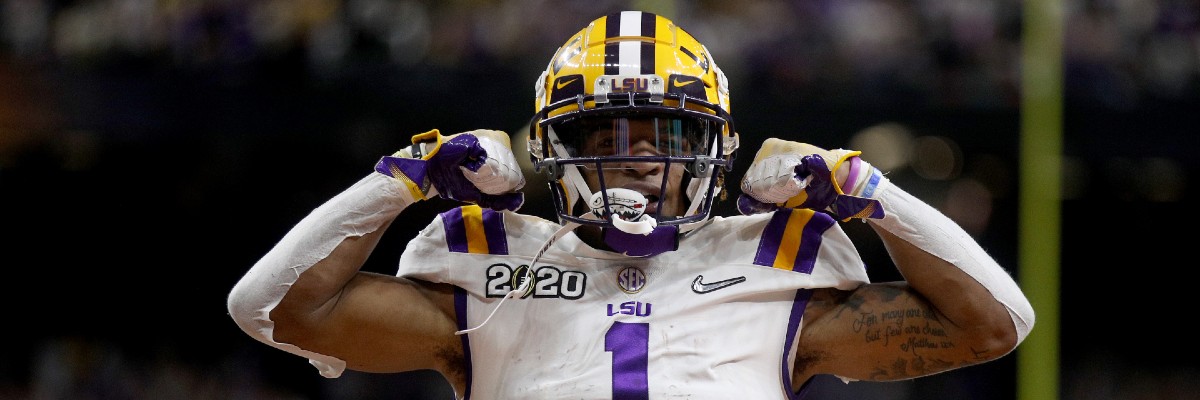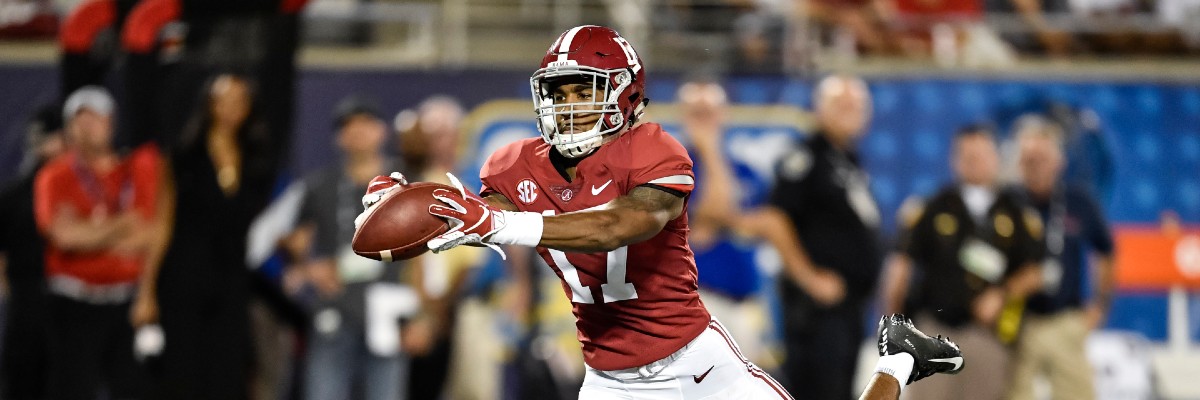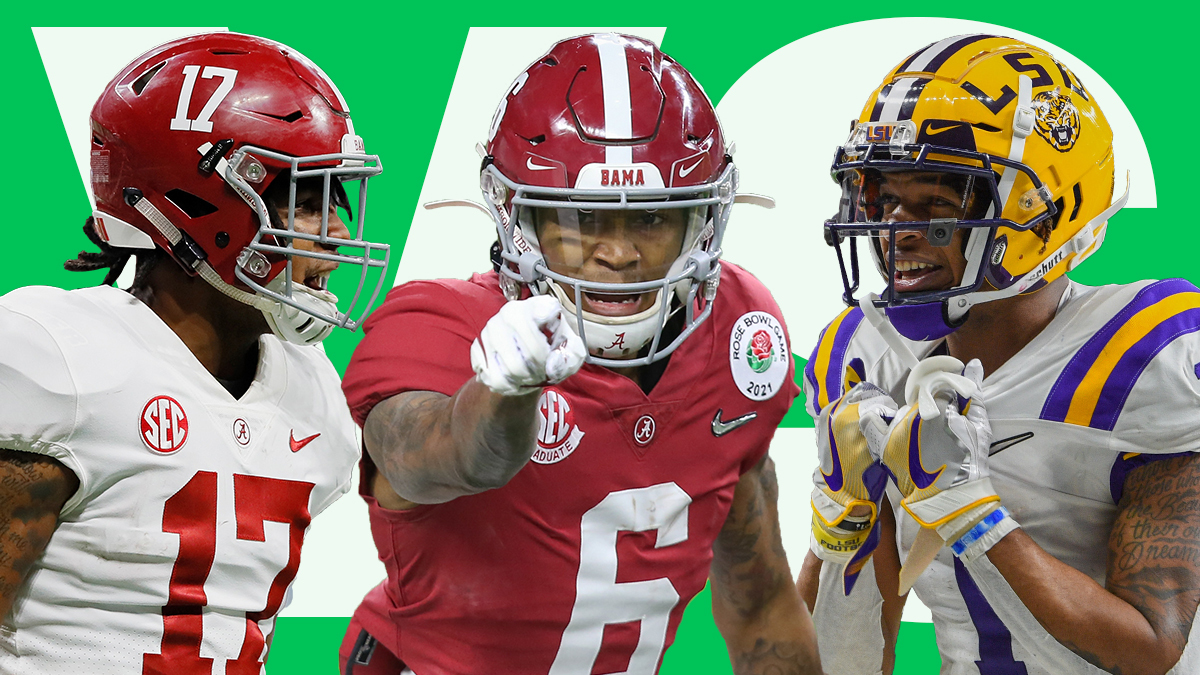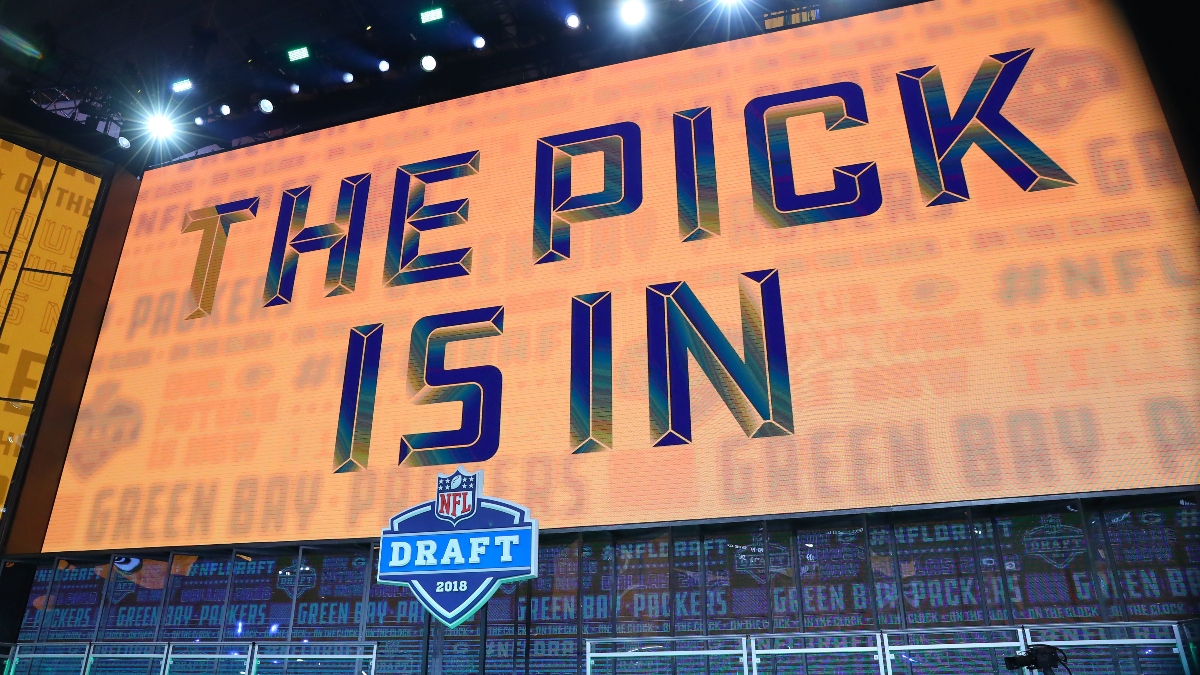Is DeVonta Smith, Ja’Marr Chase Or Jaylen Waddle the Top WR In the 2021 NFL Draft?
Getty Images. Illustration by Katie Richcreek. Pictured: Jaylen Waddle (left), DeVonta Smith (middle), and Ja’Marr Chase (right).
There are a number of wide receivers looking to take the step from college star to perennial NFL All-Pro.
Among those are DeVonta Smith, Ja'Marr Chase, and Jaylen Waddle. Smith recently became the fourth wide receiver to ever win the Heisman Trophy, Chase was a favorite target of Joe Burrow's on one of the best college football offenses of all time, and Waddle rivaled Smith in production week in and week out while healthy.
So, who deserves the title of best receiver in the 2021 draft class? Chris Raybon, Kyle Remillard, and Darin Gardner debate that question below.
More NFL Draft Debates: Can Kyle Pitts make an immediate impact in Year 1? | Who should be the third QB drafted? | Is Travis Etienne or Najee Harris the best RB available? | Could Zach Wilson be considered the No. 1 QB?
The Case for DeVonta Smith
By Chris Raybon

DeVonta Smith became just the fourth wide receiver ever to win the Heisman Trophy, joining Johnny Rodgers, Tim Brown, and Desmond Howard. The fact that there have only been three and one is in the Hall of Fame tells you just how rare Smith’s talent is.
Yes, Ja’Marr Chase is over a year younger and dominated with 1,780 yards, 21.2 yards per reception, and 20 touchdowns as a sophomore in 2019, but what Smith did that year was still impressive, leading an Alabama receiving corps that included 2020 NFL first-rounders Jerry Jeudy and Henry Ruggs, as well as Jaylen Waddle, in receiving yards (1,256) and touchdowns (14) while averaging 18.8 yards per catch. On a per-route basis, Smith and Chase were equal, both averaging 3.52 yards per route run.
Given that Smith and Chase were neck-and-neck heading into 2020, I’m rolling with the player who was able to craft his game for another year and turn in maybe the best receiving season in college football history.
Drafting is an exercise that's all about maximizing upside and limiting risk, and there's no denying Smith’s upside given the rare group he joined by winning the Heisman. And because he was able to develop his game for an extra year, I believe there's less uncertainty, or risk, than with Chase, who sat out.
We also have to remember that Chase put up his massive season during an all-time year from Joe Burrow. Chase no doubt contributed to that, but again, we simply haven't seen him do it yet otherwise, creating uncertainty.
Pretty much everyone who watches college football agrees that Smith is a better route runner than Chase, and at the end of the day, getting open is what it's all about. Chase’s ability to separate vertically is unparalleled, but Smith can be a more complete receiver.
I'd rank Waddle third, because despite his speed, he still doesn't profile as a better vertical threat than Chase. Meanwhile, Waddle has been clearly outplayed by his teammate, Smith, over the past two years, averaging nearly a half-yard less per route run (3.56 vs. 3.98).
The biggest knock on Smith seems to be his slight frame (6-foot-1, 175 pounds), but this is not a concern for me.
I view the lack of successful receivers with his frame not as a knock, but as an indication of just how rare his skill set is, especially as a route runner. And there's also upside in his frame — at 6-foot-1, he's taller than Chase (6-foot) and Waddle (5-foot-10), and while you can't add height, you can add weight.
Photo Credit: Todd Kirkland/Getty Images.
The Case for Ja'Marr Chase

Ja’Marr Chase is the appropriate betting favorite at -800 at BetMGM to be the first wide receiver taken in the 2021 NFL Draft. He decided to sit out of the 2020 season to prepare for the draft, and he proved through his pro day that he made the most of that time off.
Chase’s sophomore season was one for the history books as he set the single-season SEC record for receiving yards and touchdowns.
He totaled 84 catches for 1,780 yards in 2019, which ranks 14th all-time for a single season. Chase also averaged 21.2 yards per reception and grabbed 20 touchdowns, and more impressively, 14 of those came from receptions of 20-plus yards. He won the Biletnikoff Award as the nation’s top receiver and was a unanimous All-American as well.
Chase is one of the top deep-ball threats in recent memory who has unmatched ability to create separation at the top of a route.
Chase shined brightest on the biggest stage when he broke the yardage record for a National Championship game against Clemson, totaling 221 yards and two touchdowns.
DeVonta Smith put up similar numbers with 215 yards and three touchdowns in this year’s National Championship game. But those stats came in the first half against a subpar Ohio State defense that was prone to allowing big plays all season. The Buckeyes couldn’t stop a nosebleed, allowing 621 total yards to the Crimson Tide in that game and left Smith wide open on multiple plays.
Smith and Jaylen Waddle both had incredible careers at Alabama, but it’s hard to determine who was better during their collegiate tenure.
Smith is a proven playmaker who had an outstanding 2020 season that included winning the Heisman Trophy. But his 166-pound frame is absolutely concerning at the next level. Not only will that size hurt him in winning 1-on-1 matchups at the line of scrimmage, but it leaves him prone to potential injuries.
Chase, meanwhile, is freakishly strong and uses his physicality to dominate anyone who dares to press him at the line of scrimmage.
Waddle is a true speedster who has shown he is dangerous in the open field. He is also a bit undersized at 5-foot-10 and 180-pounds, and compared to the other two receivers, needs to improve on his route running. He played in only six games in the 2020 season, and his lingering ankle injuries that left him sidelined for most of the National Championship is a tad bit concerning.
Photo Credit: Chris Graythen/Getty Images.
The Case for Jaylen Waddle

If I’m spending a high pick on a receiver, I want someone who moves differently than everyone else on the field. You only need a few seconds to see that with Waddle.
He’s an incredible deep threat but also much more nuanced as a route runner than other first-round deep threats we have seen in recent years like Henry Ruggs and John Ross.
Waddle’s acceleration off the line and in and out of breaks may be even more impressive than his straight-line speed. His 87-yard touchdown against Texas A&M this season is one example that showed the traits that put him in a different class of athleticism than Chase or Smith.
Waddle also has some incredible data points to highlight his ability down the field. He averaged 51.3 yards per target on go routes in his career, per Sports Info Solutions. He also averaged 30.4 yards per target on all explosive routes. Florida’s Kadarius Toney came in second in that regard and was still a full 10 yards behind Waddle at 20.4.
Additionally, 36% of Waddle’s career targets resulted in a gain of 15+ yards, and he had a 142.3 passer rating when targeted on routes 20+ yards down the field, according to PFF. Both were highest in the class. You don’t see receivers this dangerous very often.
In addition to being the most explosive downfield receiver in this class, he’s also the best receiver after the catch in my opinion. The way he can erase angles with the ball in his hands is rare. You don’t see Waddle’s combination of explosiveness and after-the-catch ability very often.
If you want to see this for yourself, I recommend watching the Auburn game from his sophomore season. What he does with the ball in his hands as a receiver and as a returner is special. According to PFF, he averaged 9.8 yards after the catch during his career, which was their highest ever recorded. His 24.7 yards per punt return in 2019 also broke a PFF record.
Photo Credit: Roy K. Miller/Icon Sportswire via Getty Images.
Smith Rebuttal
Raybon: Smith has been averaged more yards after the catch per reception (8.8) than Chase (6.9) for their careers.
And while Waddle has averaged more YAC/R (9.8) than Smith, his overall dominance in market share for not one, but two, years among top-tier NFL prospects is a big indicator of superiority. Market share is one of the most predictive metrics as far as success on the next level.
Furthermore, Smith’s career average depth of target is 10.9 while Waddle’s is 10.0, which shows that Smith wasn’t just gobbling up easy throws while Waddle was clearing out space — Smith was the higher volume guy while often working at similar depths of the field.
The true knock on Smith is always going to come back to his frame. But again, I think any debate about the rarity of his frame is offset by the rarity of his skill. If you want to argue that it’s more difficult to win with a frame, then how can you argue with achieving a feat so rare as to become the fourth player at his position ever to win a Heisman?
Chase Rebuttal
Remillard: The biggest knock that most have had on Chase is his decision to opt out of the 2020 season.
Although Chase’s famed stats from the 2019 season speak for themselves, what makes him stand out from the two Alabama receivers is his freakish strength combined with unbelievable athleticism. He showed off that strength in his pro day, where he put up 23 reps on the 225-pound bench press.
Chase proved to be elite in yards after catch, as he broke 22 tackles in the 2019 season and ran through people much like A.J. Brown.
He was clocked running a 4.38 40-yard dash along with recording a 41-inch vertical jump. That leaping ability allows him to come down with 50/50 balls like a 6-foot-5 receiver. Combining the speed and strength of Chase makes him nearly impossible to cover 1-on-1 on the outside.
The numbers that Smith put up alongside Jeudy, Ruggs, and Waddle are extremely impressive.
But many forget that Justin Jefferson was the No. 2 receiver behind Chase for the 2019 LSU offense. Jefferson put up 1,400 yards of offense and seven touchdowns in his rookie campaign in the NFL. That kind of stat line helps prove that the sky's the limit for what Chase is capable of.
Waddle Rebuttal
Gardner: Waddle does not have any counting stats that come anywhere close to Chase and Smith, but his efficiency was off the charts when he was on the field.
In terms of yards per route run, which just measures total receiving yards divided by the number of routes ran, Waddle topped both guys. Waddle was at 3.57 for his career, compared to 3.12 for Chase and 3.1 for Smith, according to PFF’s draft guide. Another stat that surprised me was that he had a lower drop rate than Chase for his career: 3.4% to 5.7%.
Also, these other two receivers don’t come without concerns.
Chase made a lot of contested catches in college, but I’m not sure how well that will translate to the league. He’s only 6-feet tall, and NFL corners are going to be a lot better at playing the ball in the air than what he faced in college. He doesn’t create separation like Waddle or Smith.
As far as Smith is concerned, he would just be a massive outlier at his current weight. I’m still a huge fan, but 166 pounds is incredibly small for an NFL player. It never showed up as an issue in college, but you have to at least take it into account when looking at previous receivers who came out at that size.
Final Thoughts for Smith
Raybon: I believe it’s Smith, not Chase, who is the most complete receiver in this class.
Smith ran out of the slot on 36.9% of his routes last season compared to 17.2% for Chase in his big 2019 season. Any film guru will tell you Smith is the better route runner, and he got to hone that craft for another season against top-notch competition (he was the only receiver we’ve seen get the best of LSU cornerback Derek Stingley Jr.).
Waddle has one edge on Smith: speed, and while it is true that he did have a great run before getting hurt, the larger sample still points to Smith being the alpha in terms of market share. Not to mention, Waddle has spent 77.2% of his career routes in the slot, which can end the “who is the more complete receiver between he and Smith?” argument in its tracks.
Smith is an outlier, but not just because of his frame… because of how elite of a receiver he is.
Final Thoughts for Chase
Remillard: Burrow took 32 sacks in 10 games and is coming off a torn ACL that ended his rookie season.
Despite that, he is willing to put his own health on the line by passing on offensive tackle Penei Sewell and advocating that the Bengals select Chase fifth overall. That’s because Burrow knows that Chase is a generational talent.
Chase is the most complete receiver of this year’s bunch, as his elite strength and speed can’t be matched. His 41-inch vertical, combined with his ball skills, allow him to attack the ball at its highest point. Chase’s ability to get open vertically is something that will translate over to the NFL immediately on sideline fades and streaks down the seams.
If the demand for quarterbacks wasn’t so high, I would fully anticipate Chase to be a top-three pick in the draft. Although he still may be a top-five selection, I think whoever lands Chase will be getting someone who will come in and have an immediate impact on their franchise.
I believe that both Waddle and Smith will succeed in the NFL if they’re utilized correctly. But Chase is going to be special and a name that we may see enshrined in Canton one day.
Final Thoughts for Waddle
Gardner: If Waddle hadn’t gotten hurt against Tennessee, there’s a chance he would’ve been the one holding the Heisman Trophy at the end of the year.
Prior to Waddle’s injury, he had actually out-produced Smith. Waddle had 557 yards on 22.3 yards per catch with four touchdowns before the injury, while Smith had 483 yards and four touchdowns on 12.8 yards per catch.
Waddle’s numbers would have been incredible at the end of the year. He gets knocked for being a slot guy, but only 60% of his snaps came in the slot this season before getting hurt. He can win from the inside and outside.
Waddle will be one of the most dangerous players in the league the second he steps on the field. With the way the NFL is going on offense, Waddle is exactly what I want in a receiver prospect.
I tried to make it through this whole argument without doing the typical Tyreek Hill comparison, but it’s hard not to when watching Waddle play. He has the highest ceiling among this group, in my opinion.
How would you rate this article?








